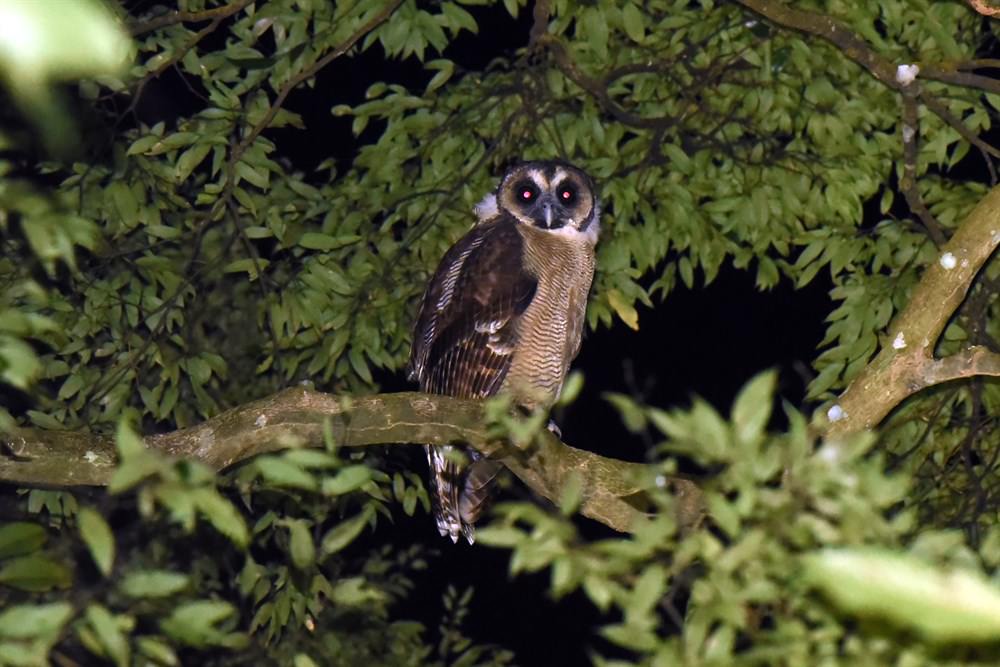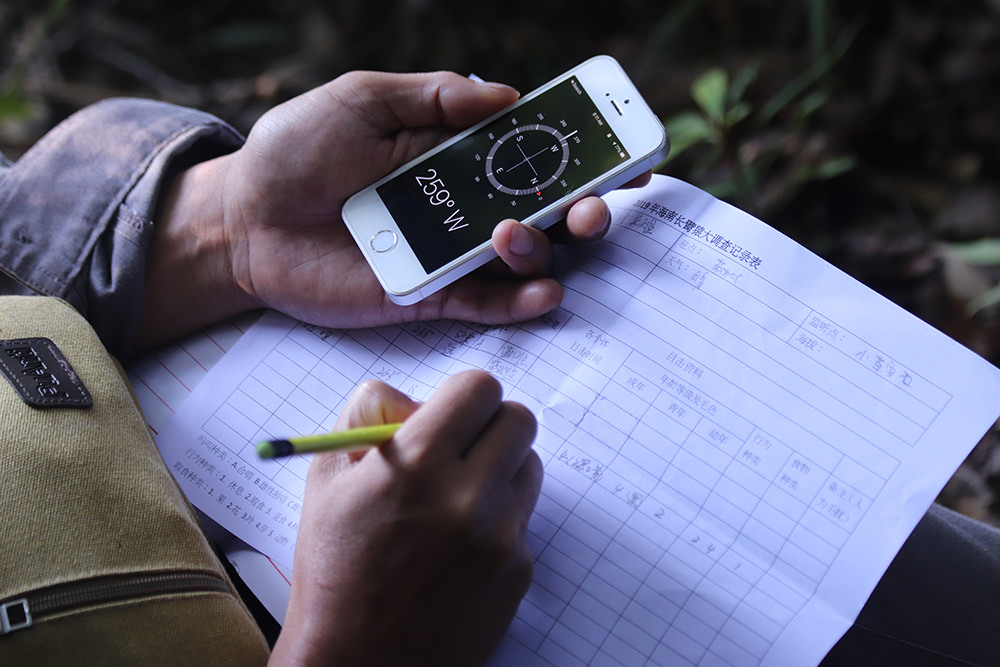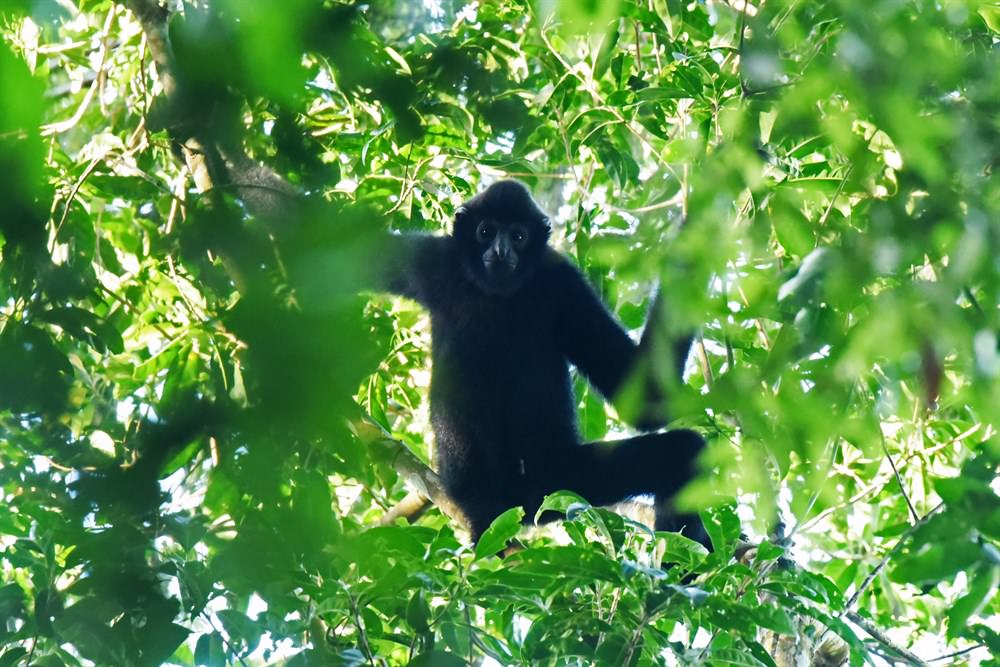Tracking the world’s rarest primate in the rainforests of Hainan
On the first morning monitoring Hainan Gibbons at Hainan Island’s Bawangling National Nature Reserve, my team tracked the species’ biggest family unit, Group C, in hopes of catching a glimpse of its 10 members by following the direction of their haunting, full-throated songs as they echo through the jungle. As we descended from a listening post on the mountaintop, we found a clearing in the forest that opens up to a view of a majestic tree standing tall and proud on a steep slope with lush mountains in the background. I thought to myself: If the gibbons were hanging out here, this would be picture perfect. I couldn’t believe that this would come true on day three. The gibbons appeared in the treetops not far away, and we had the luxury of observing them unobstructed by thick foliage as they gracefully picked fruits from branches for breakfast, hung by one arm from a branch and flung themselves through the air to another tree metres away like aerial acrobats..jpg)
Hainan Gibbons are born aerial acrobats
.jpg)
Pre-survey training for the monitoring team
This was the first time I participated in the annual population survey of Hainan Gibbons – also known as the world’s rarest primate since there are only 29 individuals living in four family groups left according to the 2018 census. This year, we put together a 42-strong team of staff from Kadoorie Conservation China, Hainan Bawangling National Nature Reserve, Hainan Bangxi Provincial Nature Reserve, Yunnan Gaoligongshan National Nature Reserve, and Yunnan Tongbiguan Provincial Nature Reserve for this important mission. We divided into seven teams and set up 19 listening posts in the heart of gibbon territory. From dawn to noon, Hainan Gibbons sing to strengthen family bonds and mark their territory. The team would first pinpoint the gibbon’s location through listening to the direction of their songs, then track down them down and count their numbers.

Brown Wood Owl
.jpg)
Northern Reed Snake
Every morning, my team crawled out of bed at an ungodly 4:30am to eat a simple congee breakfast, and then we hiked 2km uphill under a starry sky using our headlamps to light up the way. We had to reach our listening posts located 900m above sea level before day breaks and before the gibbons wake. On our way, we heard a Brown Wood Owl call as if to cheer us on, but a drowsy Indochinese Green Magpie wasn’t too pleased to be startled from its sleep. We also bumped into a Northern Reed Snake, a Pointed-scale Pit Viper, and an Arcuate-spotted Pygmy Frog which added excitement to our trek in darkness.
.jpg)
Tracking Hainan Gibbons in the lush rainforest

Recording the time, direction, distance and type of the gibbon calls, the number of gibbons seen and the GPS location of the monitoring team
My first exposure to Hainan Gibbons was their alarm call which I thought was very loud and resonating for an animal of such a small built. Another hour later, as the community ranger in our team led the way to trace down the gibbons following the source of their morning songs, I finally caught my first glimpse this endangered ape. It was then the patriarch of the troop of 10 gibbons broke into song and his two partners responded with otherworldly and elaborate vocals that build to a captivating crescendo of notes that can be heard over long distances. It is a duet that makes the world stand still and leaves a deep impression in your heart.
The duets of female and male Hainan Gibbons are unforgettably beautiful

Male Hainan Gibbons sport a black coat
Whenever the gibbons made an appearance, our heads tilted 90 degrees backwards, our long lenses pointed towards the crown of the trees. We couldn’t resist firing off the shutter rapidly to capture precious images of the juveniles playing catch dozens of metres above ground. But sometimes we put our cameras away and observe through our binoculars those sweet, precious moments of a golden-coated mother gibbon grooming her infant. There is a particularly daring and curious juvenile in the troop that always inched closer and closer to inspect us. At one point, it tilted its head upside down and we locked gaze as if in a staring contest in which the person who looks away or laughs first lose the battle.
.jpg)
A blonde female Hainan Gibbon with her infant
What makes the Hainan Gibbon interesting, apart from their haunting chorus, is that the colour of their coat changes throughout their lifetime. Regardless of their gender, all Hainan Gibbons are born light blonde and take on a black coat when they turn six-month-old. Then at the age of five or six, females turn golden again, while males keep their dark fur. When females grow old, they grow some black hair once again. Both adult female gibbons in Group C gave birth in the past year. From photos taken by our camera traps in June, we could see a fair-haired new-born clinging tightly to its mother’s chest with its slender long arms like a little peanut. Now at about four months old, its coat is already black, but there is still a patch of golden fur on its neck that betrayed its young age. Female gibbons reproduce every two to three years and their young, including this little peanut, will be dependent on their care for two years.
It was an honour to become one of the few people in the world who not only have seen the Hainan Gibbon, but also about one third of its global population. Listed as a Critically Endangered species by the IUCN Red List and a Class I Key Protected Species, the species is only found in Hainan Island and now only distributed in Bawangling National Nature Reserve. Our survey results will inform us on the species’ latest population and family dynamics. The data will also tell us whether they are facing any threats and whether our conservation work and scope is sufficient. We hope the Hainan Gibbons will thrive and continue fill the valley with their enchanting song!
Author: Joyee Chan (Project Officer of Kadoorie Conservation China Department)

